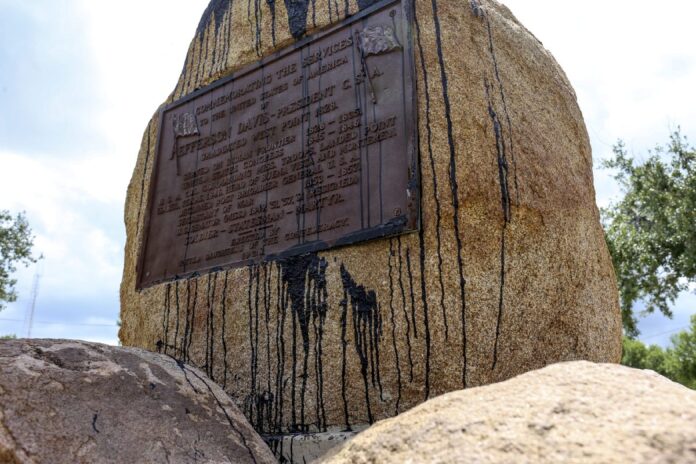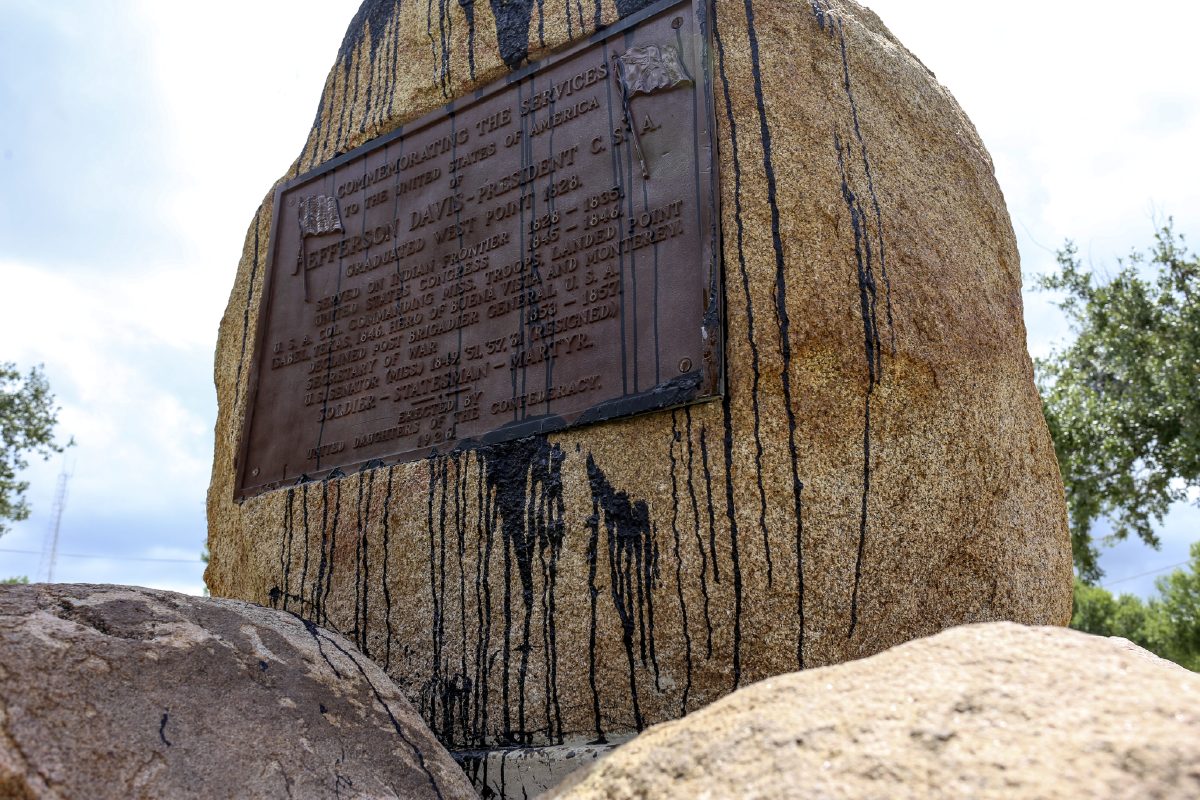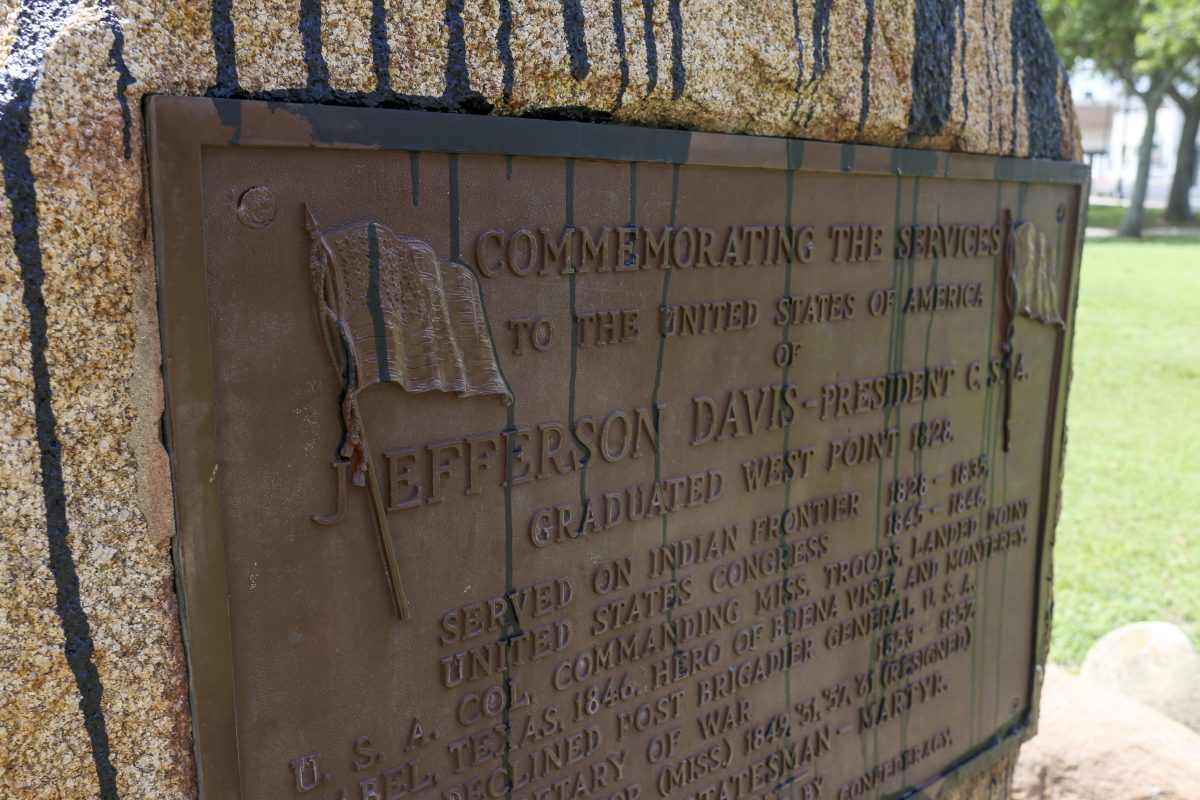Outrage in the wake of George Floyd’s death at the hands of the Minneapolis police has re-ignited the push to remove the 92-year-old monument dedicated to Jefferson Davis, the one time president of the confederacy, from Washington Park.
Over the weekend, someone splashed black paint on the monument and painted the words “No Racist Idols”across the front.
The Brownsville City Commission will discuss removal of the monument at a City Commission meeting at 5 p.m. today via Zoom Meeting. The item was placed on the agenda by Commissioner Jessica Tetreau and Mayor Trey Mendez.
Activists have long fought to have the rock and plaque honoring Davis removed, citing a need for the city to take a stand against racial injustice and white supremacy, a legacy from which Davis and those who fought to keep slavery alive in the United States cannot be separated.
Mendez told reporters last week the plaque does not reflect the values of the community, and expressed hope that the city can get the matter of the statue’s removal finalized.
The question of whether the monument belongs to the United Daughters of the Confederacy or the city itself has been in question since protests began in 2018. The city appeared to have determined it had the authority to remove the rock and was in touch with the Brownsville Historical Association to add it to the Brownsville Historical Museums’s collection.
BHA’s executive director Tara Putegnat confirmed this in a statement. “The City of Brownsville and the local chapter of the United Daughters of the Confederacy were to establish who owns the monument and once ownership of the monument is confirmed, the Brownsville Historical Association would be willing to accept the monument as a gift to our collection,” she wrote.
Mark Kaswan, an organizer with the local coalition Frontera Progressives, said the group has had trouble getting in touch with the association to discuss the statue’s removal and how it will be displayed once removed. “Frontera Progressives has taken the position that if it is to be donated to the historical museum, it needs to be on the condition of the museum establishing a process for community engagement and involvement,” he said.
Another group, Arte Civico Circle, expressed to organizers that they would prefer the memorial is removed and destroyed, period. Frontera Progressives offered officials an alternative, expressing their interest in simply removing the plaque and replacing it with a message that honors the community’s diverse history.
“Two years ago, we took the position that there be a community-informed process and that the rock needed to be displayed within the context of the United Daughters of the Confederacy’s campaign to promote white supremacy,” said Kaswan. “We are no longer really confident that the museum is going to do that. Our interactions with BHA have not been positive.”
Frontera Progressives is calling for the statue’s “immediate” removal, which organizers feel needs to happen as soon as possible — hopefully within a few days following today’s City Commission meeting on a motion to remove the monument, and the march to demand racial justice that will follow.
Kaswan noted that back in 2018, there was never any formal agreement to remove the statue. Frontera Progressives alleged the decision to give the statue to BHA was spearheaded by officials without first discussing it with those calling for the monument’s removal.
“On the one hand, we’re thrilled that it looks like the city is finally going to move on this. But one thing that needs to be clear is that we don’t want the city to make the decision to move the stone once the museum has figured it out. The stone needs to be moved into storage immediately,” said the organizer.
“I also hope that through this process people take the opportunity to think about the fact that issues of racial justice are not just black and white — that the Latinx community in the Rio Grande Valley has been deeply affected by white supremacy.”
Although Mendez was contacted for comment on the ongoing removal process, the city did not wish to discuss the monument before the scheduled commission meeting.
In a statement posted on Facebook last Thursday morning, Commissioner Nurith Galonsky expressed the need for community leaders to address the legacy of white supremacy and the oppression of people of color across U.S. history. “It stands to reason that historical monuments honoring these individuals further entrench their power and legacy, and influence how history is remembered in public spaces,” she wrote.
“If we keep monuments like “The Rock” to remind us of historical atrocities, then where are the reminders of the hardships Blacks endured day to day (for ex., segregation, lynchings, and rape) versus the privileged lives of the Whites? Furthermore, what about the other cultures or ethnicities living in Brownsville? Why are their experiences silenced?”
Galonsky called for a dialogue of justice, equality, and peace. Last weekend, the commissioner reached out to UTRGV history professor and associate director of the CHAPS Program Christopher L. Miller in an effort to verify the monument’s history. Miller’s response indicated there is no proof Jefferson Davis even set foot in the State of Texas.
Miller wrote, “The connection between Brownsville and Jefferson Davis is extremely tenuous. The route proposed by the United Daughters of the Confederacy for the Jefferson Davis Highway for the most part followed US 90 through Houston and then went on westward through Austin and beyond. There was a proposed ‘coastal spur’ that would have run from Houston to Brownsville, but there’s no indication that this ever got off the ground. Perhaps the donation of the monument was designed to curry local political support for what was a flagging project.
“In any case, there was no personal connection between Davis and Brownsville and I can find no record of his having ever been in the state, much less in Brownsville. As to the highway project itself, in an article in the academic Journal of American Studies, authors Euan Hague and Edward H. Sebesta point out that this was part of a national white supremacy campaign which, timing-wise, corresponded with the reformulation of the KKK (1915).”
Galonsky said, “Of course, people are going to say we can’t forget our history. I’m not saying everyone should forget about it, but this man was of no consequence to Brownsville.”







